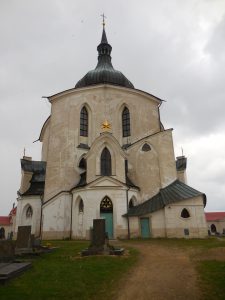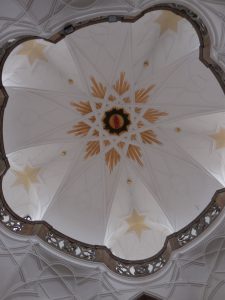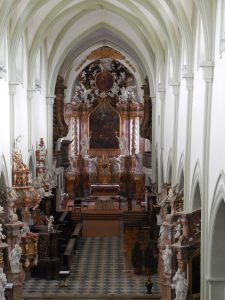Zelená hora and Žďár nad Sázavou
By Tracy A. Burns
 Zelená hora and Santini
Zelená hora and Santini
A UNESCO World Heritage Site, Green Mountain (Zelená hora) consists of a church and cloister area with five chapels and five gates on the hill. The word unique does not do it justice. Designed by Bohemian architect of Italian origin Jan Santini-Aichel, it demonstrates his Baroque Gothic style, which utilizes Gothic elements in a Baroque way. Zelená hora, which dominates the countryside, is filled with geometric symbolism. It was Santini’s last work before his death at age 46 in 1723, and perhaps it is his best-known creation of the 80 or so buildings he designed.
Santini’s background
Santini’s parents wanted him to become a stonemason like his father, but due to palsy, he was not able to take up that profession. During Santini’s student days, French architect and painter Jean Baptiste Mathey was his mentor. Mathey was inspired by classical rationality and designed the Troja Chateau in Prague. Spending four years in Italy greatly influenced the aspiring Bohemian architect. Santini admired the designs by Italian architects Francesco Borromini and Guarino Guarnini and their radical Baroque style. Santini made his mark on many religious sites. Baroque art was in vogue when the Catholic army triumphed in the Thirty Years’ War and continued to be the favored style when Catholicism flourished in the Czech lands.
The importance of Saint John of Nepomuk
In 1719 Saint John of Nepomuk’s tomb was opened, and the tissue considered to be his tongue remained intact. Žďár nad Sázavou monastery Abbot Václav Vejmluva wanted to celebrate the saint and his canonization, so he had Santini design the Holy Shrine of Saint John of Nepomuk and the cloister area in his unique way, with geometric precision. Construction began in 1719, and the church was consecrated in 1722.
The number five and its symbolism
 The number five is of great significance in the design. The ground plan looks like a five-pointed star, and there are five altars in the church. The number five symbolizes the five wounds of Christ and Christ’s five fingers of blessing. It also stands for the five stars that, according to legend, appeared when the Queen Sophia’s confessor John of Nepomuk was drowned in the Vltava River on the orders of King Wenceslas IV, for refusing to reveal the queen’s secrets.
The number five is of great significance in the design. The ground plan looks like a five-pointed star, and there are five altars in the church. The number five symbolizes the five wounds of Christ and Christ’s five fingers of blessing. It also stands for the five stars that, according to legend, appeared when the Queen Sophia’s confessor John of Nepomuk was drowned in the Vltava River on the orders of King Wenceslas IV, for refusing to reveal the queen’s secrets.
The main altar
The main altar is decorated with a scene of St. John of Nepomuk rising from a globe that is decorated with five eight-pointed Cistercian stars, representing the five continents where Christianity reigned. Two angels open a baldachin while three more hover around the globe.
The design of the church
 The nave of the small church is surrounded by four chapels and a chancel as well as five ante chapels. A portrayal of a large, red tongue, symbolizing Saint John of Nepomuk, decorates the dome. A circle of flames coupled with rays of light surrounds the tongue. The windows above the entrances in the lantern chapels are shaped like tongues, too.
The nave of the small church is surrounded by four chapels and a chancel as well as five ante chapels. A portrayal of a large, red tongue, symbolizing Saint John of Nepomuk, decorates the dome. A circle of flames coupled with rays of light surrounds the tongue. The windows above the entrances in the lantern chapels are shaped like tongues, too.
Žďár nad Sázavou’s monastery
Nearby, Žďár nad Sázavou monastery, built in the 13th century, is another sight to behold. Santini cast his spell in the Church of the Assumption of Our Lady with the monumental organ lofts that are located in front of a Gothic altar in the transept. He also redesigned the naves. The Baroque decoration, too, is outstanding. Santini’s style can also be seen elsewhere in the convent, such as in the water well chapel, the south wing of the quadrature, and the spiral staircase in the west wing. The prelature is not to be missed, either. Its large, astounding fresco celebrates the Cistercians.
The Lower Cemetery
Santini made his mark on other buildings in the town, too. He designed the Lower Cemetery, shaped like a human skull with three chapels. It was built because Žďár nad Sázavou wanted to be prepared for the onslaught of the plague spreading throughout Europe. Because the plague never came to Žďár nad Sázavou, no one was buried there.
A town worth exploring
Žďár nad Sázavou is a town well worth exploring. Zelená hora shows off Santini’s outstanding, unique style and fascinating geometric precision. The monastery and convent are to be admired as well. The design of the Lower Cemetery is captivating.



